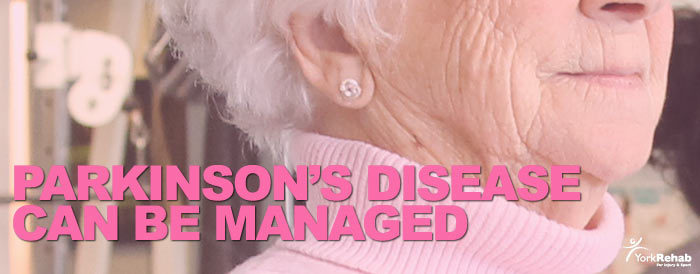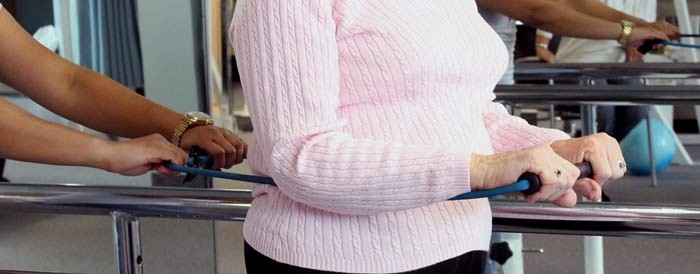Neurological
Parkinson’s Disease Can Be Managed
Parkinson’s disease (PD) is a progressive disease of the nervous system marked by tremor, muscular rigidity, and slow, imprecise movement, affecting mostly middle-aged and elderly people. It is associated with degeneration of the basal ganglia of the brain and a deficiency of the neurotransmitter dopamine. PD is known as a chronic, long-term condition that will require ongoing monitoring and management to maintain the patient’s quality of life.
Most common symptoms: tremor, slowness and stiffness, rigidity of the muscles, decreased initiation of movements and impaired balance that can lead to repetitive falls.
Other symptoms: fatigue, soft speech, depression, decreased motivation, constipation and sleep disturbances.
Usually the management of the disease is based on drug treatment and multidisciplinary care for the long term, slow and progressive symptoms.
Once the diagnosis of PD is made, the next step is to decide on a rehabilitation program that will prevent decline of the patient’s mobility, maximizing safety and independence.
A specialized Registered Physiotherapist can develop a treatment program, according to each patient’s needs. The program might include:
- “cued” exercise training
- treadmill training, gait re-education
- balance
- improvement of movement initiation
- improvement of range of motion (BIG movements)
- enhancement of aerobic capacity
- improvement of functional independence, including mobility and activities of daily living
- education on PD self – management
These all result in benefits. However, continued therapy is required to sustain benefits and gains. This is particularly important with Parkinson’s Disease patients since lack of initiation and motivation can be a barrier to rehabilitation.
You can live better and we can help!
Living Well After A Stroke
The number of people having a stroke in Canada is increasing each year and it’s not just the elderly who are at risk. In practice we are seeing more and more young people surviving a stroke. Some stroke statistics:
- Every seven minutes a Canadian dies of heart disease or stroke;
- 80% of Canadians have at least one of the risk factors for heart and/or vascular disease;
- In 2009, about 315,000 Canadians living in the community reported that they had suffered from the effects of a stroke.
1. WHAT IS A STROKE?
Stroke is a “brain attack” caused by a disturbance of the blood supply to the brain.
2. TYPES OF STROKE
There are two main types of stroke. ISCHAEMIC STROKE is the most common. It’s caused by a clot narrowing, or blocking blood vessels so that the blood cannot reach a particular area of the brain. The lack of oxygen supply leads to the death of brain cells. HAEMORRHAGIC STROKE occurs when a weakened blood vessel in the brain bursts. This produces bleeding in the brain and therefore, damage. Sometimes surgery is necessary in these cases. MINI STROKE – also known as TIA (TRANSIENT ISCHAEMIC ATTACK) – is similar to a stroke and has the same signs, but gets better within 24 hours. However, it must be seen as a warning sign of a more serious stroke in the future and must also be treated as a medical emergency.
3. SIGNS AND SYMPTOMS OF A STROKE
By being aware of the signs and symptoms of a stroke, you could save the life of a family member, a friend or someone in your community. ACT F.A.S.T!
FACE – can the person smile? Is one side of the face drooping?
ARMS – can the person raise both arms?
SPEECH – is their speech slurred?
TIME – time to call 911 right away if you see any one of these signs.
Act FAST because the quicker you act, the more completely the person may be able to recover!
4. RISK FACTORS
Medical conditions: high blood pressure, high cholesterol, atrial fibrillation, diabetes.Lifestyle: smoking, physical inactivity, being overweight, poor diet, stress.
5. WHAT HAPPENS AFTER A STROKE?
Depending on the area of the brain affected and the type of stroke, patients will have different results. The most common physical effect, and the one best known to the public, is decreased mobility of one side of the body. As with any brain injury, patients will present generalized fatigue and decreased ability to cope with everyday activities. Patients may also have speech and cognitive impairments that can be addressed in a multidisciplinary treatment approach.
6. HOW CAN A PHYSIOTHERAPIST HELP A STROKE SURVIVOR?
Physiotherapy looks at the physical aspects of health. A Registered Physiotherapist can help stroke survivors increase their mobility, independence and overall endurance. A Registered Physiotherapist will perform a complete assessment to understand the impairments and functional mobility status and will tailor a rehabilitation program. Reducing the risk of falls, and making the person safer and able to move independently, are primary goals after a stroke. We can help you to live well!



